#Overgarment
Explore tagged Tumblr posts
Text
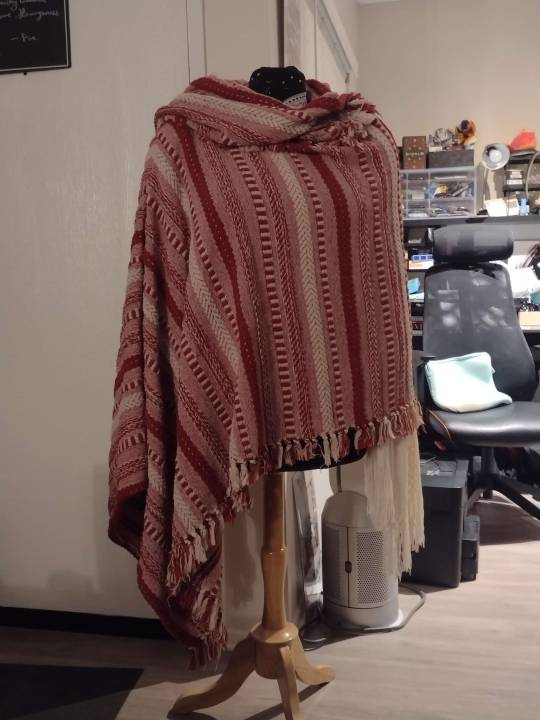

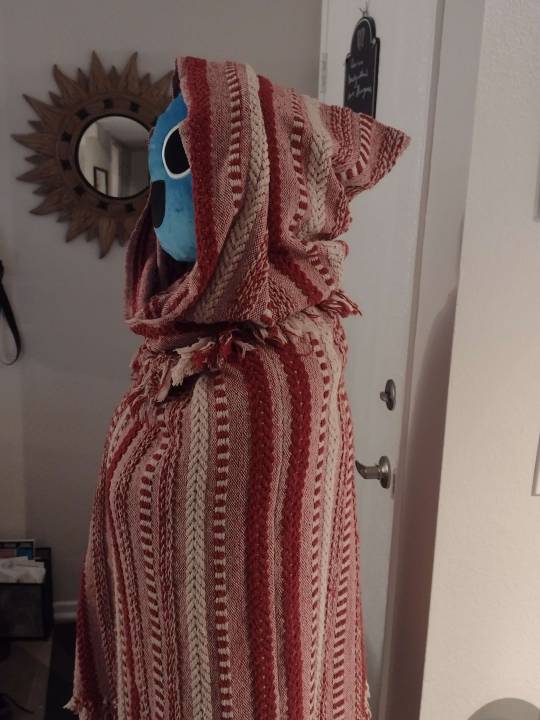

I made this poncho out of about one and one third blankets. It's neat. The plush currently serving as Marie's head is a Doomlings plush and the cream knit blanket peeking out is being used to bulk out the arm area to make the poncho hang more or less correctly.
It can be worn with the hood opening and body seam at either shoulder or at center front. I don't have a photo of the center front position because i don't like it as well visually so I went 'meh' and simply didn't take any.
Assembly was done by hand using crochet cotton I had on hand because it was about the right color.
#sewing#fashion#costumery#costuming#Im back on my bullshit#this is actually basically an oc cosplay item#but like not for a specific oc#for a whole ass culture of ocs#or rather for one subset of persons within the fictional culture#who wear simple mostly-red hooded cloaks coats or ponchos for traveling as companions to younger community members#who are experiencing the Wanderlust(TM) that is very common in their population#when you get the Wanderlust someone will go with you#and they will wear red so you can spot them easily in most environments and for luck#you can ask a specific person to travel with you by presenting a red hooded overgarment as a gift#some folks make their own tho#or are given one by settled down family or neighbors as a going away gift
10 notes
·
View notes
Text
one thing the borgias REALLY goddamn got right was undergarments. everyone had a shift on under those gowns every dude was wearing an undershirt and god i fuckin LOVE IT
#my kingdom for period and fantasy shows that remember and consider the historical value of fabric and clothing#'rae its not that impo-' YES IT IS YES IT IS UNTIL FAIRLY RECENTLY FABRIC WAS EXPENSIVE#AND IT WAS TREATED AS SUCH. PEOPLE DIDN'T HAVE BIG WARDROBES OF OVERGARMENTS#AND THEY WORE SIGNIFICANT AMOUNTS OF UNDERGARMENTS TO PROTECT BOTH THE BODY AND THE GOWN#and also to effect how garments were shaped and how they laid on the body#i'm having a moment again where i think about the hotd costuming and i want to lay down and weep because ohhhh my god it grates at me
5 notes
·
View notes
Text
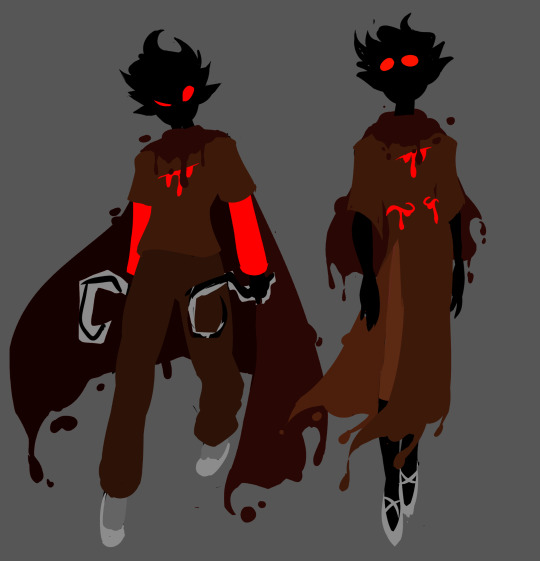
concept: blood players god tier fits behaving more like liquid (moving slightly, droplets coming off and disappearing into nothingness). for example knights cape and seers hood + lower part of the overgarment would act like that. no idea how to clearly explain this i just think its neat
#homestuck#karkat vantas#kankri vantas#homestuck fanart#god tier#knight of blood#seer of blood#blood aspect#i have so many lil design ideas for how to individualise aspects from each other mmmgh#might do more in the future but this ones my favourite#also was thinking that heart players hoods should be shaped more like hearts
4K notes
·
View notes
Text
Sewing mid-16th century Venetian dress in doll scale
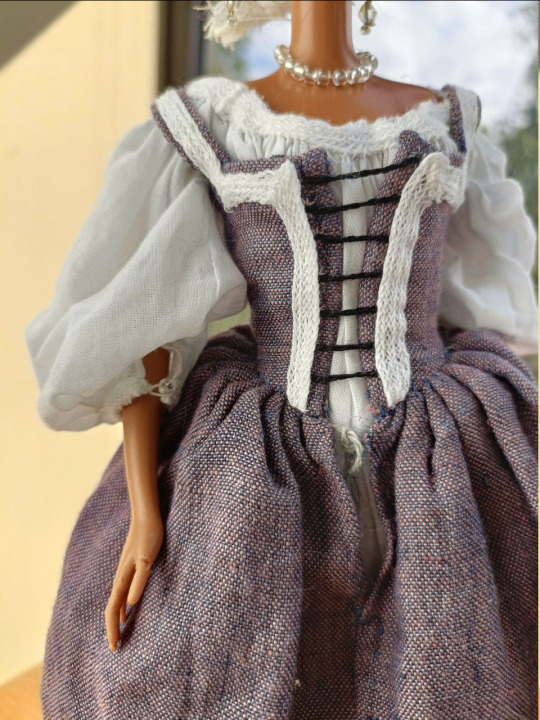
My parents moved from my childhood home, so I needed to finally take all my old toys I want to keep to store myself, including my dolls. For a long while I've been thinking it might by fun to sew tiny historical clothing for dolls. I love watching doll customization videos, they are so satisfying, and I just really love it, when there's a normal sized thing and then you make it tiny. Especially if it's still functional and made from correct materials. I can't explain it better than tiny versions of bigger things just make me vibrate on higher level. Now that I have my dolls in my home and a box full of fabric scraps, I have everything I need to just start sewing. So I did. And it was extremely fun. I have already started working on a 1890s doll outfit.
This will show my age (not that it doesn't read in my bio), but my dolls are all mainly My Scenes. I was Team My Scene in the early 2000s Bratz vs. My Scene wars. I did not like the proportions of Bratzes. All my My Scenes are Madison, she was my girl.
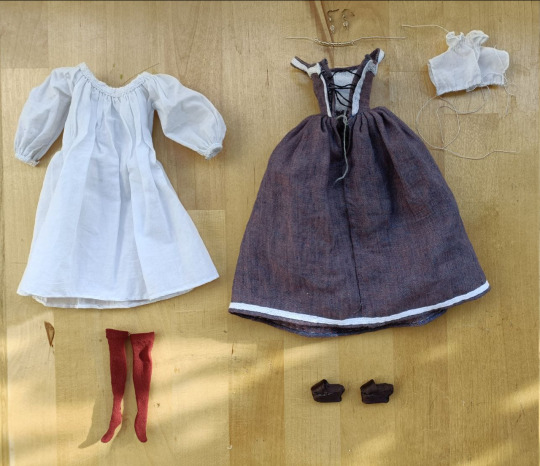
Here's all the items I made. I tried to use as much historical methods as was possible on doll scale and hand-sewed everything. I made a shift, hose, dress, necklace, earrings, partlet and shoes. I did almost make detachable sleeves, but I wasn't happy with them and I will need to remake them. It took me so long to finish one sleeve and I was very frustrated when I wasn't happy with the result, so I will need some time to make a second attempt.
Underlayer
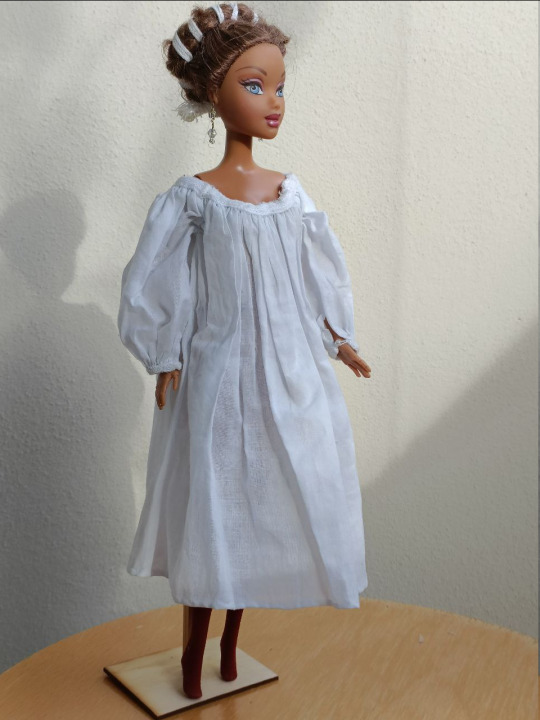
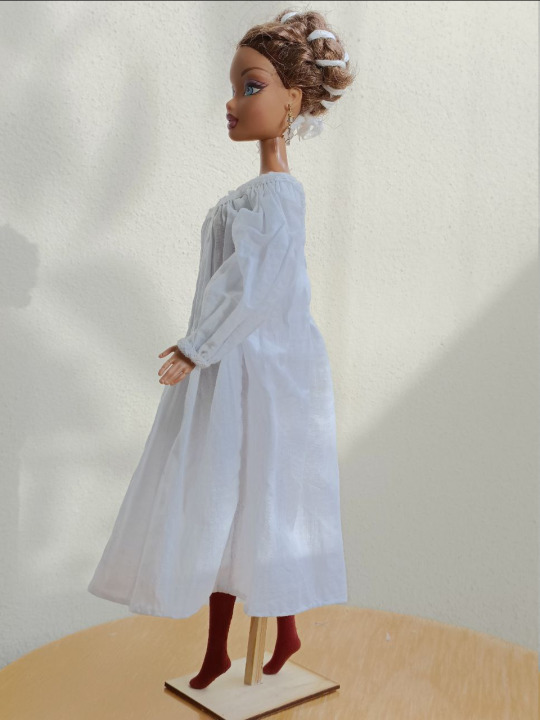
I have finer white cotton than linen so I used the cotton for the shift and partlet, even though cotton wasn't really used widely at the time, definitely not in underwear, but it worked better in this scale. I didn't have thin enough wool for the hose, so I used fabric from my old thin stockings. Knitted stockings were not quite yet a thing so that's not very accurate, but that's the best I got. I choose red since red hose seemed to have been pretty common based on Venetian paintings, where the hose are shown. I used tiny beads I had lying around as buttons for the sleeves.
I'm not super happy with the neckline. I couldn't come up with a good way to finish gathered neckline on this scale without making it bulky. In future I will try something else.
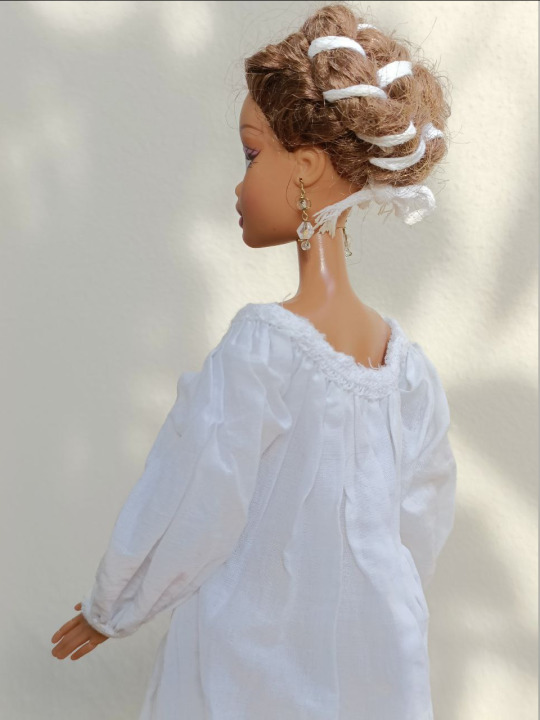
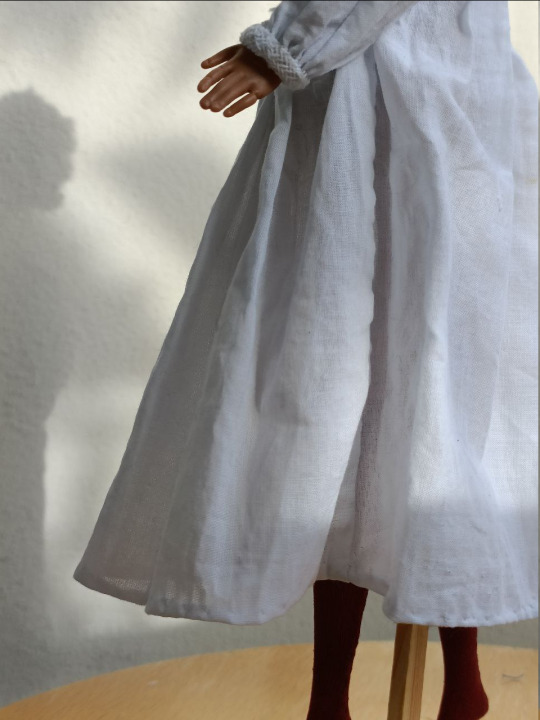
Overgarments
Dress
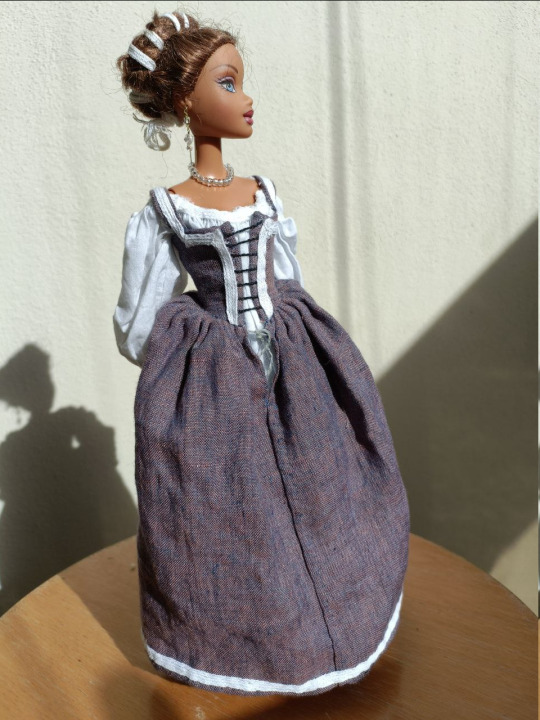
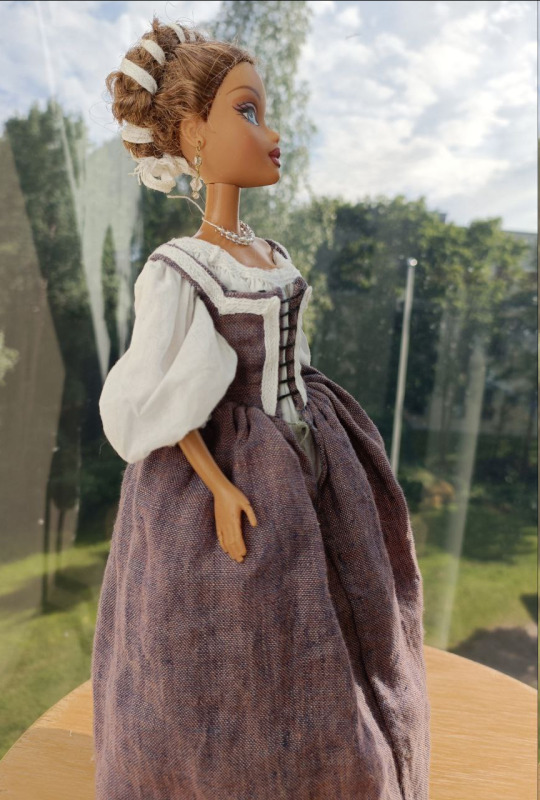
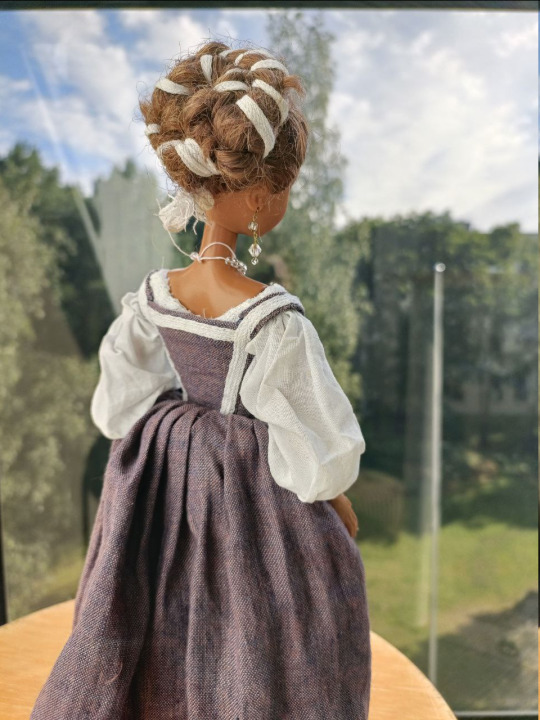
The dress itself is made from the remaining scraps of the lovely Latvian linen I bought many years ago from Riga and have already made several garments from. The skirt is cartridge pleated, though the pleats at places behave a little weirdly due to the scale. I used semi heavy linen as lining and finished the panels separately as was typical in 16th century. I didn't use any boning equivalent, but I use cording to reinforce the laced opening. I of course sewed tiny lacing holes, which was very fun. The cord for the lacing I plaited from heavy thread.
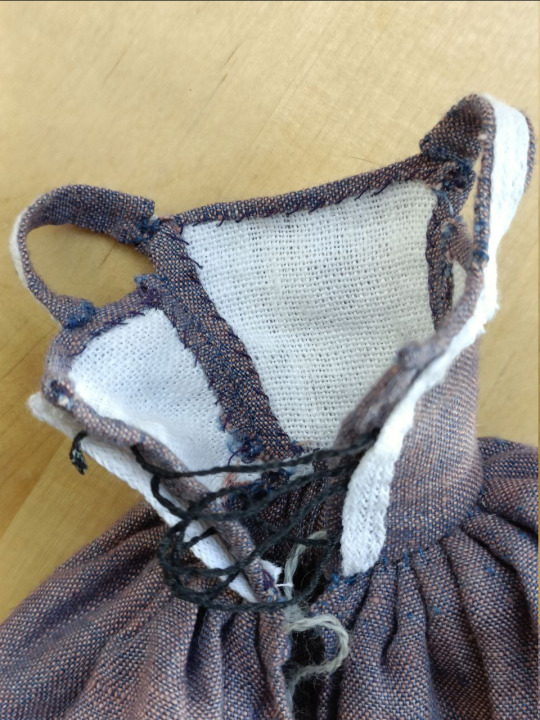
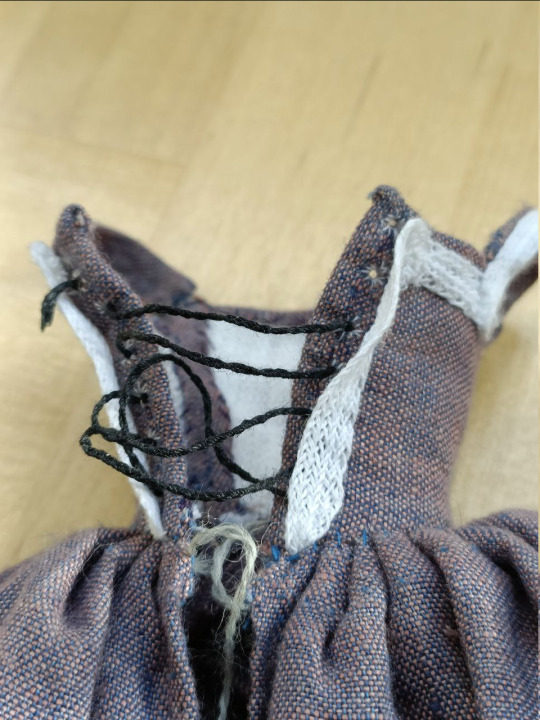
Here's couple of examples from 1550s and 1560s Venice I used as basis for the dress.

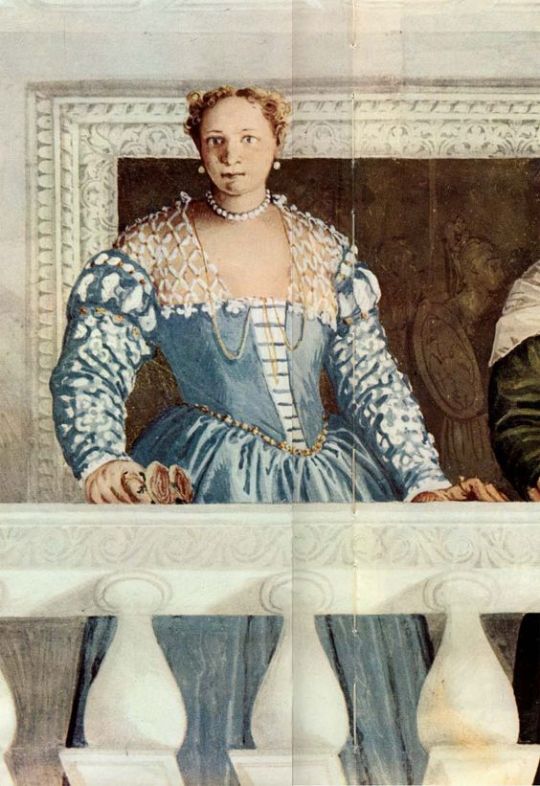
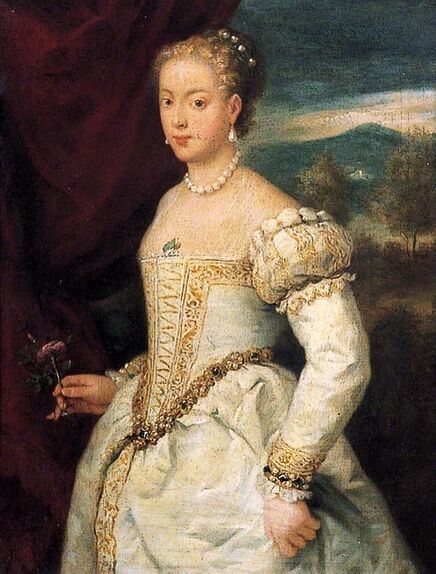
Partlet
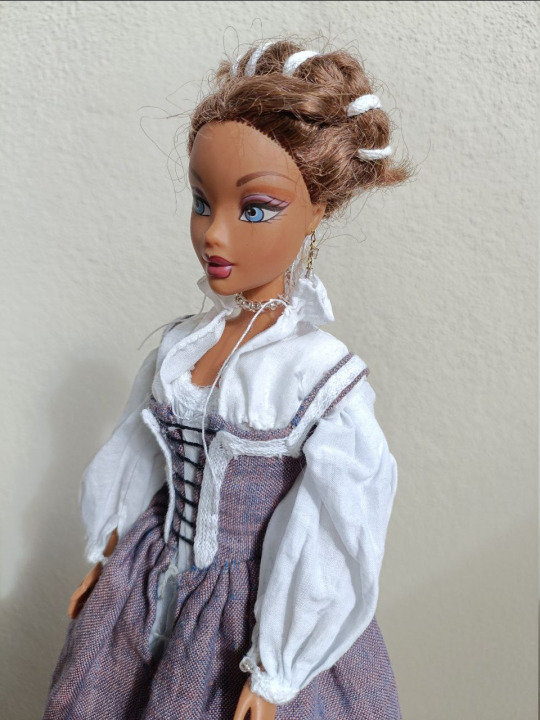
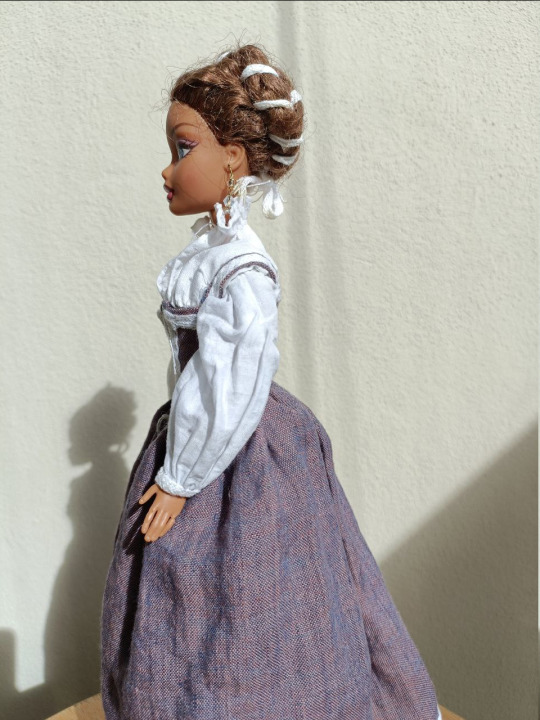
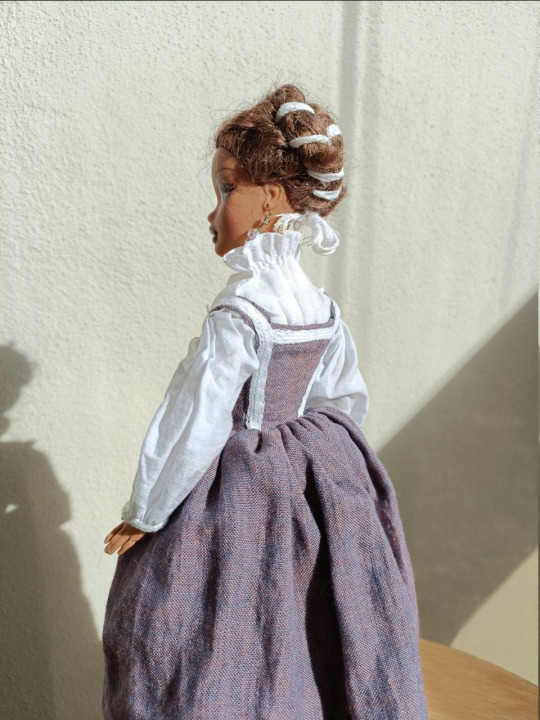
A Venetian renaissance woman of course needs her boob window partlet. Unfortunately I didn't have any super sheer linen or silk to make the fashionable sheer look.
Shoes
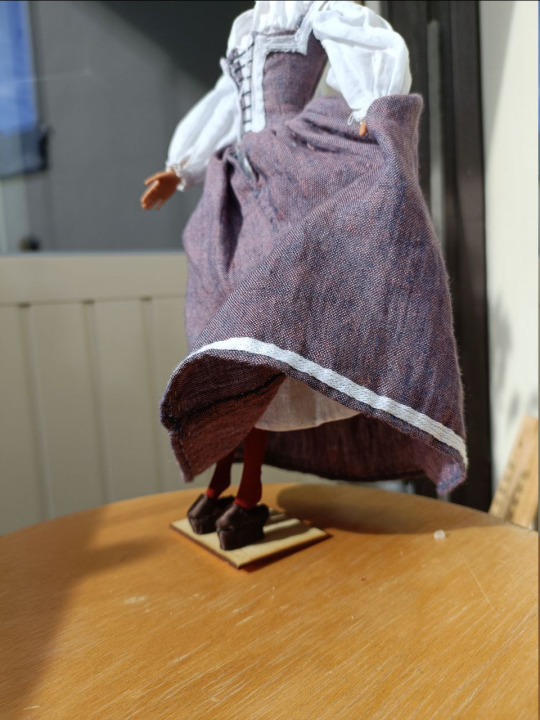
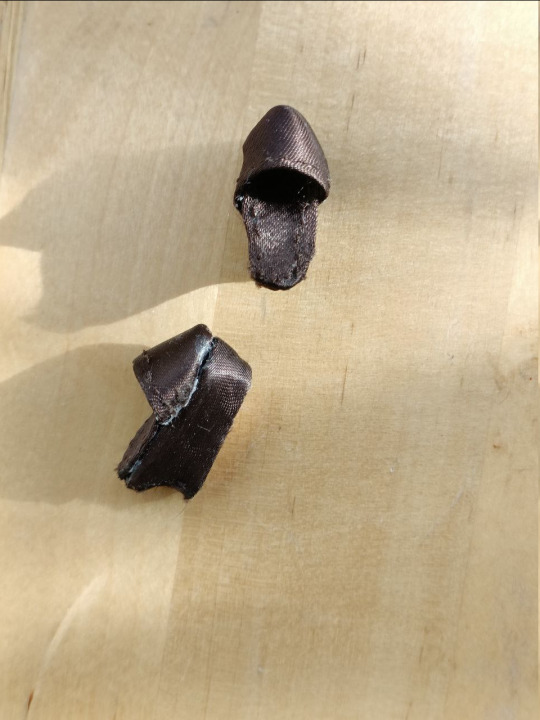
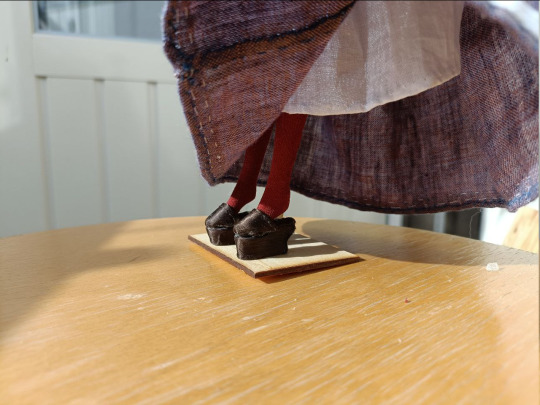
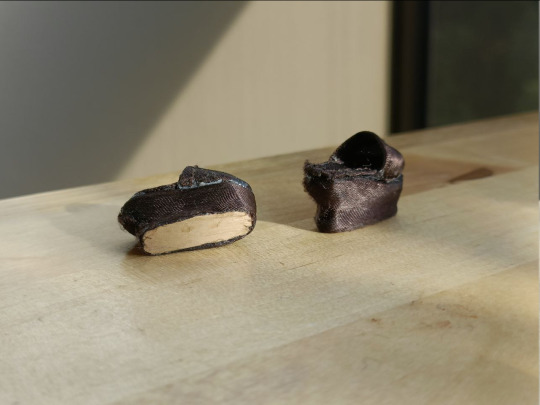
The shoes are chopines, which were very fashionable in Venice at the time. They were platform slippers with wooden base, which were covered with leather or fancy fabrics, like brocade or velvet. I didn't make the heels super tall since I was going for more toned down merchant/artisan class sort of vibe, and the very tall were used by upper class women and courtesans. I carved the heels from soft wood and covered them with sateen.
For reference here's couple of 16th century Venetian chopines.

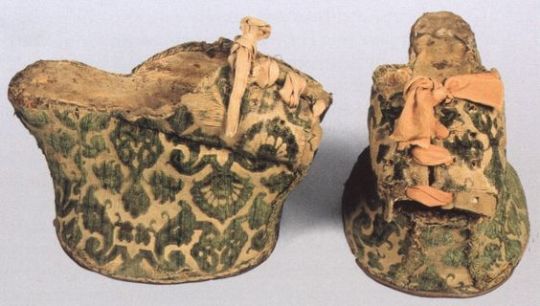
#historical fashion#fashion history#custom doll#doll customization#historical sewing#renaissance fashion#my art#historical costuming#my scene#doll#hand sewing#fashion doll#dolls
614 notes
·
View notes
Text
every appearance seems to depict it in a slightly different way so:

#this is going onto the sewing blog for.... reasons#feel free to make some assumptions 👀👀👀#atla#avatar#avatar the last airbender#toph beifong#atla toph#i feel like there is an obvious answer here but also#lots of screenshots i have do pull realllllly yellow. like a pale yellow but still. the show images are def..... not off white.....#i feel like honestly i didnt pick the best refs to show that but. i just pulled from what i already had on my phone
127 notes
·
View notes
Text

Late Bronze Age Aegean inspired Athena
(Methodology below)
Ok, so I've taken a bit of Classical inspiration as well. I read somewhere that her Peplos was saffron and purple so I took that colour scheme and was reminded of the artwork from Pylos. This lead me to being inspired by the Battle Frieze (Pylos) for the Gigantomachy detailing in her skirt. The colour scheme for the skirt is thus tans and purples for her skirt. Minoan artwork has shown more evidence for depictions of skirts with scenes and scenery on them so that aspect is perhaps more Minoan inspired.
The bodice and the apron both are inspired from the Necklace Swinger in the Saffron Gatherers wall art from Xeste 3 (Akrotiri). I've put crocus flowers as an embroidery detailing on the bodice as it is saffron dyed. The apron takes the design from the necklace swinger as it always makes me think of the night sky (due to colours) and I figured that would make an appropriate overgarment for the story of the gods vs the giants.
The aegis is blue and gold. I chose blue because Zeus has also been associated with the aegis and I wanted to add a connection to him (blue, sky god). Blue (glass) and gold was also a popular Aegean colour decision, which can also be seen in the glass diadem (wave/bracket bead) she wears, connected to a boar tusked helmet. A blue cloak with gold tassels is also somewhat inspired by the sword wielding figure in the fresco from Mycenae's cult centre although with less tassels. I've added two glass necklaces inspired by Mycenaean glass beads. She also has glass beads in her hair, something that is seen in several female figures in Minoan and Mycenaean art.
The snake is both a tie in to the Aegean Snake Goddess but also Athena's ties with snakes (Erichthonius and Medusa both have snake and Athena links, so this may be where the Classical stuff ties in, I'm less certain on the Classics stuff).
She stands in front of an olive tree on an acropolis (meant to be the acropolis of Athens but no way to identify that so could be any).
#Athena#Athens#Greek Mythology#greek myths#tagamemnon#pagan#Hellenism#Mycenaean#Minoan#Bronze Age Aegean#Greece#Aegean#Ancient Greece#archaeology#classics#my art
29 notes
·
View notes
Text
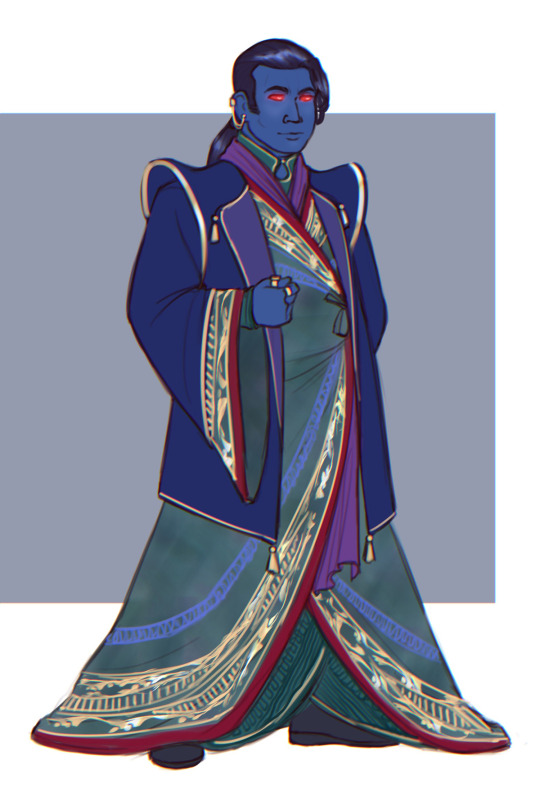
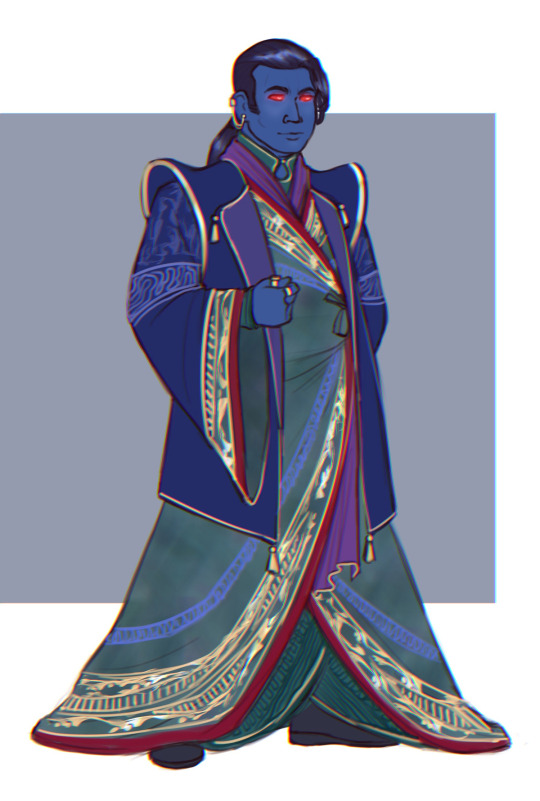
Syndic robes featuring @handbaskethell's Thrass (thank you for letting me use your headcanons for him!)
as always, headcanons under the cut
Alright, these aren’t set in stone as I’m still figuring them out but here’s what we’ve got so far:
With syndics we start to see the appearance of structured shoulders and more extravagant lapels in garments, particularly in jackets. Still no structured collars however as these are reserved for the topmost ranks. Jackets, in contrast to those worn by lower ranking administrators are made of softer flowing fabrics, like silk, with the goal of the garment being to demonstrate expensive materials and dyes rather than weave (hence rich colors and light silky textures).
These jackets are usually left with minimal decoration though some more formal occasions may merit additional embroidery and filigree. Rules regarding underrobes and outerwrap robes remain the same with one exception being the waist knot: higher ranking syndics aren’t required to replicate the knot if it’s covered by an overgarment or accessory. This is mostly due to the fact that status is reflected in the quality of the garments and syndics don’t need additional identification.
One visible element here is the trim indicating family allegiance, a band of a minimal stipulated width, always worn on the outermost edge of the garment.
Clothing rules are generally more loose for higher ranking syndics. With the exception of some traditional elements, there’s more room for variation in accessories, cuts and combinations. Nonetheless, etiquette dictates that more formal ceremonies are attended in more traditional ensembles.
Syndics are also free to pick the color of their garments based on the virtues they symbolize.
(AN: there’s a few book elements like family crests, different colored sleeves and arm bands that I haven’t incorporated yet but I want to figure out the overall rules and basic items first. So yeah, this is a work in progress.)
161 notes
·
View notes
Note
Hi Anea! I was searching for "antique" chinese fabrics on the web and found there were many cheap brocade/embordered fabric on TaoBao that is similar to the fabric in the mandarin coat. Would it be a good idea to remake the mandarin coat using the fabrics? (0 experience first timer)
I mean, why not? I think the main thing about the costume is that it needs texture, surface, embroidery, fringes, details. And using brocades and embroidered fabrics will add to that. But I would make sure the base is made of solid fabrics. Chinese brocades are good in this aspect. Fragile, flimsy materials can be saved for the decorations, where they are put on another surface.
Apart from rich Chinese brocades and embroideries, you can also cut out motifs from suitable fabrics and apply them on to your robe / tabard. Add trims around it, maybe some sequins, and it's a super effective and sometimes money-saving feature.
The costume itself consists of four main features:
The main robe, straight, with long wide cuffs and a standing collar. This is often made of Chinese brocades, with some additional details on the cuffs and maybe collar.
The tabard, the sleeveless overgarment reminding of a long, loose waistcoat. This one can be straight or pointed, it may or may not have a collar, it can be open + tied at the sides, or sewn together, and the back is usually richly ornamented. Many versions also do a fringe or tassel trim at the hem. Sometimes the main robe and tabard is merged into one, or at least it's hard to tell where one ends and the other starts.
The cloud collar, a pointed, rounded and decorated collar. This is not done in all versions, as for example the US costumes only tend to indicate it with trims.
The round, pointed hat (which I won't really address here).
When they built a new costume for Ben Lewis in West End the base of the robe, tabard and collar was various Chinese brocades, but then slowly adding texture to the collar and the back of the tabard, using trims, embroidery, fringes, appliquees etc. The main robe itself doesn't need much decorations apart from the pattern and colours of the fabric. With the exception of the cuffs, of course. They are usually made of different rows of fabrics and trims.
Here's the Ben Lewis costume in making:


I didn't think that costume turned out super textured on stage. I would have liked to see a dash more surface to the collar. But I do like the various blue shades, especially that reminding of peacock blue. Here it is worn by David Thaxton some time later:

A new costume they made for Scott Davies and Tim Howar around the same time also had a base of chinese brocades, and with various structured trims, appliquees, embroideries etc. Again I don't think the collar is the most textured one in West End, but it is still cool to see it in process from costume workshop to stage.


The one they made for Marcus Lovett was more textured. Especially with that embroidered dragon back, but also the ornamentation of the collar. Here it is in making:

And as it appeared on stage, here worn by Ben Lewis:

I would also say the same logic can be applied to other versions of the costume around the world: Chinese brocades as a base, and various embroideries, trims, tassels and appliquees adding structure and bling to make it rich-looking.
Here's the Danish one, as worn by Tomas Ambt Kofod and John Martin Bengtsson. I love the bold blue nerve in the collar, cuffs and lining. It's also not super visible, but there is a lot of antique embroideries in the back and inner collar.



Many versions follow this composition, though with different colours, fabrics and details. Some will have a separate cloud collar, while others indicate a collar by the use of trims. The US is a good example. They do various trims around the neck and tabard, or the trims illuded a cloud collar that is an integrated part of the tabard. Here's Laird Mackintosh on Broadway:

And the back of what I think is the same costume, as worn by Hugh Panaro on Broadway:

The cloud collar shape is even less present - or rather, not at all - in the 1990s versions of the costume. Here's Michael Lackey and John Cudia in US Tour runs. Even if we're not talking the same costume, they are both made of a black and gold Chinese brocade for the main robe, and blue Chinese brocade with large, round ornaments for the tabard. The standing collar is accentuated by trims.

Same goes for the Australian and early World Tour ones. They did the main robe and tabard, but rarely the cloud collar. They did however do amazing vintage gold embroideries and silk-painted details. Here's one worn by Jonathan Roxmouth in his South African run. I love the wing pattern coming to view in the collar and back:


Same also goes for the Japanese ones. They do a main robe with a tabard on top, and the tabard has trims and details denoting a collar rather than a separate cloud collar. They have used many types of fabrics and colours throughout the years, but this recent purple one will forever remain a favourite. The first photo is Yuta Iwaki in Tokyo. I wanna say the second photo shows Osamu Takai, but don't quote me on that...


A final version I will post is this elder German one. Again, the cloud collar shape is only indicated by trims. But they have also added frog fatening in front, which I think is a nice detail. Depicted is Thomas Schulze in Hamburg:

I hope this at least gave you some inspirations on materials used, possible shapes, colours etc. :)
#mandarin robe#mandarin coat#phantom of the opera#maria bjørnson#costume making#costume nerding#ceris donovan
21 notes
·
View notes
Text
Vashwood au where Vash is just some guy and Wolfwood is a car mechanic who (in fast and furious fashion) goes to illegal races. He usually doesn't race but he loves looking at the engines and giving unsolicited advice. Some of the racers are his clients but he tries not to get too involved but business is business.
One time during a race, Vash just walks in the middle of things by accident, as he usually does. He's not sure what was going on but this handsome black haired guy with sunglasses and a buttoned down shirt started mansplaining to him and he just rolled with it. By the time Wolfwood realized Vash was a random passer by, there was sirens starting to surround them. Wolfwood hopped on his motorbike, Vash in panic followed, squeezing the breath out of Wolfwood the entire time.
They barely got away and Wolfwood vowed to never be swayed by a cute face again.
A week later one of the neighborhood kids comes to pump their soccer ball on the car repair shop's tire pump. It wasn't unusual, and neither was it unusual that they asked him to play with them. What was odd was that they said "so we have equal teams" and the equality came from the fact that Vash was on their other team.
After a few conversations Wolfood finds out that Vash is actually the urban legend people called "Stampede". The racer who never entered "formally" and had a car that looked older than time but always finished with massive advantages. He's only been in three or four races and he never stopped at the finish line. No one had seen his face but people say he had blond hair and a bright red overgarment.
And it turns out he was just late to pick someone up from somewhere, and another time he was in a rush before his favorite donut place closes, and the list of reasons grow more ridiculous.
#trigun au#vashwood#vashwood au#vash x wolfwood#racer au#like fast and furious but way chiller because wtf is going on with that franchise#it's insane... not necessarily bad but... yk#and sillier
70 notes
·
View notes
Text
Shlaim falsified timeline in order to blame Zionists for Iraqi exodus
The Oxford professor Avi Shlaim’s memoir ‘Three Worlds’ has been amply reviewed, but few reviewers have treated the book to an analysis as forensic as Gilad Ini’s. Writing for CAMERA, Ini finds that Shlaim is torn between his twin roles as historian on the one hand, and mudslinger against Israel on the other. At times he acknowledges that Iraqi persecution of Jews was “the main reason for the Jewish exodus from Iraq,” but ends up concluding that the Zionists planted bombs to cause the Iraqi Jews to flee, going as far as to falsify the chronology of the explosions in order to reverse cause and effect.

Avi Shlaim: questionable chronology
We felt vulnerable because we were Jews,” he admits. It was already in 1948, before the series of bombs but after an anti-Jewish gang threatened to kidnap or kill members of his family, that his mother began “thinking about leaving Iraq for good.”
The bombs, he later elaborates, compounded a feeling of insecurity that had already existed:
The real reason for leaving, according to my mother’s later account, was that life in Iraq had become too dangerous by 1950, for the Jews in general and for our family in particular. Persecution of the Jews was intensifying, and it assumed many different forms. The government, the judiciary and the public became overtly hostile. Restrictions were placed on Jewish trade and commerce. Jews in the civil service were dismissed and the entire community was placed under surveillance. Young Jews were barred from admission to colleges of further education. The police arrested, tortured, imposed arbitrary fines and extracted money from innocent Jews in what looked like a government-sanctioned campaign of harassment.
And yet he allows himself to conclude elsewhere, “My family did not move from Iraq to Israel because of a clash of cultures or religious intolerance.”
This is part of a pattern. Though Shlaim is willing to detail antisemitic mistreatment, he is equally willing to shrug it off when making sweeping judgments.
Were Jews “subjected to a host of discriminatory regulations” over the centuries? Yes. But no matter. They were “the living embodiment of Muslim-Jewish co-existence.”
Was there an “infamous pogrom” —the anti-Jewish bloodbath known as the Farhud? Sure. But just one. “The overall picture, however, was one of religious tolerance, cosmopolitanism, peaceful coexistence and fruitful interaction.”
What of the “harassment,” “Nazi militarism,” “official persecution,” “anti-Jewish propaganda,” “strident anti-Jewish … sentiments,” the “powerful popular wave of hostility toward … the Jews,” demonstrators who “marched through the streets of Baghdad, shouting ‘Death to the Jews,’” a “government that actively whipped up popular hysteria and suspicion against the Jews”? Rest assured. “Iraq was a land of pluralism and coexistence.”
The absurdity seems to know no limits. If during the Farhud “an angry mob armed with knives, sticks and axes set upon the Jews on buses, in the streets, and in their houses,” and if Jews were “murdered, raped, looted” until 179 Jewish corpses were tossed into a mass grave, Shlaim still finds someone to insist that the pogrom was “not an antisemitic episode.”
Shlaim’s mother didn’t get the memo. After the Farhud, she and her Jewish friends “began to wear abayas, the loose black overgarment worn by Muslim women, in order to conceal their Jewish identity. They also imitated the dialect of Iraqi Muslims, fearing their very voices would give them away.” Just as Ms. Shlaim made clear that their family left Iraq due to anti-Jewish persecution, she left little doubt that she understood the antisemitism behind the Farhud.
But Avi Shlaim knows better than his mother. He is, after all, a professional historian. One who changes dates. One who ignores chronology. One who dismisses facts that don’t suit his politics. But a professional—for what it’s worth.
Read article in full
More about Avi Shlaim
13 notes
·
View notes
Text
Arrival
1,186 words | Mirai and the serpent king (sequel to Apprehension)
Content | Slavery, fear, dehumanisation, implied future noncon
Notes | Mirai arrives at the serpent king's palace, and prepares to meet his potential new master!
Taglist | @yet-another-heathen @echo-goes-aaa @whumpinator

The palace appeared out of the greenery, all lattices and domes and carved decor, all rather too beautiful to belong to a dumb beast. Maybe the king would care about the singing, after all; Mirai felt a sting of fear and humiliation both at the thought. Soon they passed through an elegant archway, under the watchful eyes of more guards, and after that, the road was paved with slabs of some smoothly dark grey stone, grooves carved into it in elaborate patterns.
The outer parts of the palace were quite open, one arch next to another looking into rooms and corridors alike. They were brought into one such airy room, where a snake man behind a desk took note of their precence on a large scroll, looking like they were the most exciting thing to happen today, sent off what appeared to be a messenger into the deeper parts of the palace, and instructed them to wait.
There was a marble bench at the inner side of the room, opposite the windows, and the slavers took their seat. Mirai didn’t need instruction to kneel on the floor instead. The grooves still present here dug into his knees.
The slaver holding him yanked on his chain hard enough to momentarily steal his breath. »Over here, we’ve got to do something about your hair.«
Mirai obediently turned to present the back of his head, blinking back the tears from the shock of the pull; he would never be able to handle that. Immediately, he had to wonder whether the serpent king enjoyed this sort of thing. Many snakes liked to strangle their prey, didn’t they?
He bit his cheek trying to push the thought out of his head. It didn’t matter; he couldn’t change a thing about what was to come.
He always did his best to maintain his hair himself, limited as he was to his bare hands, because he knew the slavers wouldn’t be gentle when it came to doing him up for the market. He squeezed his mouth shut against the comb ripping at what tangles he hadn’t been able to get rid of, and tried to let the slaver’s swearing at him about what a nuisance he and his hair was, as if he chose to keep it as long as it was, pass over him.
It took too long for the slavers not to get bored. One of the others leaned in. »You know, they say no one leaves the snake king’s harem. ‘Cause he eats the slaves he grows tired of.«
He was kneeling on the floor that had by now become outright painful, terrified over his future whichever way it might play out, and that was what finally pushed the tears into spilling over. He heard the slavers snicker as he hugged himself, trying to get a hold on himself.
One of them slapped the back of his head. »Get a grip. The king won’t want you all puffy.«
»Get out of that,« the one doing him up said, ignoring their companion.
Mirai pulled his tunic off; if ever he had been able to afford shame, it was long gone by now, and his only worry was what his naked form might entice any observers to do to him.
»And clean yourself up while you’re at it.«
He wiped the dirt off his bare feet, knowing full well he’d have to put this same tunic back on if he failed to sell. He rubbed what travelling grime he could off himself; it was a far cry from being truly clean, but it was all he could do now. The slaver grabbed him by the back of his neck and rubbed rose water behind his ears and under his jaw.
Then he was tossed his nice, clean, white market tunic. It was shorter than the travelling one, barely reaching his mid-thigh. At least the air was warm; the slavers had already shed their overgarments in the humid heat, although they weren’t quite as exposed as he, and complained to one another, quietly, clearly still unwilling to offend the guards or even the secretary.
»And don’t say a word, you hear me?«
Mirai nodded, eyes cast down. It went without saying, really, even though most potential buyers ended up insisting on hearing his voice before buying anyway—or rather, not buying, usually.
Then they waited.
The slavers, grumpily, dug into their travelling rations when midday was gone long enough to expunge any hope they would be offered refreshments. Mirai got nothing: it wasn’t like he would lose weight quickly enough now to influence the sale. After walking all morning, he was aching for even a a little snack, but he had to be grateful to be offered water alone.
Despite his discomfort, he was grateful for every moment he didn’t have to face the reality of being offered up to the serpent king; and he was so exhausted he dozed off where he knelt despite his fear. Not enough to fully lose track of his surroundings, of course, that was not a luxury he could allow himself, but enough to quiet the ache in his knees and heart.
He started fully awake when one of a pair of guards approached them, ordering the group to follow them. It must have been hours, and he felt like his knees would burst when he got up. The floor had pressed vivid pink patterns into his skin, but it couldn’t be helped now.
His heartrate picked up as they moved through wide corridors, decorated with elaborately woven tapestries. This was it. He was going to be sold to the serpent king, a monster by all accounts, or rejected and punished, but now, between the guard’s slithering bodies so very capable of crushing him, one fear was far more real than the other. They were so big, and just imagining their king’s proportions made it hard to hold back tears.
Maybe, as a member of the harem, at least only the king would have access to him, and the existence of a harem meant he wouldn't have to satisfy him alone. But then, maybe he liked to share? Maybe he liked to reward loyal guards, like the ones that eyed him curiously as they passed through the corridors?
His head was spinning with terror and what straws of hope he could cling to when they entered the throne room.
It was big in every direction, slender columns carrying a high, domed ceiling inlaid with geometrical patterns. Across from the large double doors was a dais a few steps high, with a oval-shaped cushioned seat, its curved back intricately carved, upon which the serpent king lounged. The scales covering the loops of his body were of a deep earthy brown, and he wore nothing but golden jewellery hanging over his chest and looping around his arms, and, of course, a crown.
The look of his golden eyes felt like it would pierce right through Mirai, and he had to force his knees not to buckle in terror as they were walked up to the center of the room.
#whump#whump writing#slavery whump#my writing#mirai and the serpent king#mirai#I mean of course you know it's his new master no potential about it with a title like that lol. but he doesn't!
36 notes
·
View notes
Text
6 notes
·
View notes
Text

SCP AMTF Nu-7 Cosplay - Hazardous Environment Level III
Depicted here is the standard loadout of a conventionally armed Nu-7 operative in a Level III rated hazardous environment. Each level, ranging from I to IV, has a typical hazardous environment protection requirement that outlines the necessary support that a task force member needs to complete their objectives within the working area. Note that Level IV Hazardous Environment protection encompasses all hazardous environment loadouts which include thaumatological or anomalous equipment intended to protect from specific anomalous entities or regions. As such a Level IV loadout may appear as any of the previous three loadouts with the aforementioned supplementary equipment.
Showcased here is an example of a Nu-7 operative working within a Level III Hazardous Environment. Required protection when working in this environment is a standalone gas mask with a filter rated for all CBRN threats and a fully sealed CBRN suit equivalent to US military MOPP (Mission Oriented Protective Posture) Level 4 standard. This standard includes a full seal gas mask, gas mask hood, gloves and overgloves, boots and overboots, and the CBRN overgarments itself. The standard issue gas mask of Nu-7 forces is the Avon Protection C50. This is a variant of the famous M50 which uses standard NATO 40 mm thread filters. In addition, the Avon C50 and M50 series gas masks are designed to be worn under a ballistic helmet. In this protective level, the Avon C50 is paired with a standard issue Avon Gas Mask Protective Hood. When secured to the wearer and worn under body armor this hood provides full seal protection around the neck and face. The standard issue overgloves and overboots are AirBoss lightweight models. The overgloves are paired with a glove liner for additional comfort. The overboots are worn over standard footwear. The Foundation supplies state of the art CBRN suits to all AMTF units which provide full protection against all threats while also providing some comfort for the wearer. This example is a GORE CPCSU-2 CBRN Jumpsuit. This suit uses advanced materials that allows for increased freedom of movement, less noise when moving, and less user fatigue over time.
The primary use case of Level III Hazardous Environment equipment is when the element is operating within an area that has a known threat of CBRN agents. To counter this threat, the operative is equipped with a CBRNCF50 (NIOSH) Filter that protects from all gaseous agents specified in the NIOSH CBRN standard. This operative carries his Avon C50 in a gas mask bag slung bandolier style over the right shoulder. The usual combat clothing will not suffice in such an environment, so the operative wears a CBRN suit over his standard uniform. The operative cannot remove this uniform until proper decontamination protocols are completed under any circumstances. This includes the good, the bad, and the ugly of sustainment in the working area. Because of this, AMTF units that work within such an environment are quickly rotated out in order to prevent total fatigue. CBRN suits quickly drain the wearer of water as the lack of airflow causes a buildup of perspiration and exertion increases body heat which in turn increases perspiration, causing a vicious cycle of losing liquid. As such water intake is extremely important when operating in a CBRN environment, and the C50 gas mask allows for the operative to safely drink water while in the working environment using the built-in drinking tube paired with a canteen with a gas mask cap. This drinking system allows for the user to safely drink water without the risk of exposing themselves to any deadly contaminants in the air.
The fully sealed nature of a gas mask means that it is difficult to speak through the faceblank and filter and still be understood in a combat environment. A Voice Projection Unit, or VPU, allows the wearer to speak through a microphone placed inside the gas mask that projects the wearer's voice through a voicebox mounted on the front of the gas mask. This allows the wearer to speak audibly without yelling to nearby peers. Should the element choose to speak solely through the radio, a separate wire is needed that connects the C50 to the communications headset. This allows for clear communication through the radio but decreases audible effectiveness towards anyone not within the radio network - a positive or negative aspect depending on the scenario.
Full Resolution Here.
9 notes
·
View notes
Text

IN-SCHOOL PERFORMANCES IN LAURIER / idol school dr

Obviously an idol school is gonna let their students perform on stage at some point! In Laurier, students can form groups with their friends. You can have subgroups from this group + solo stages too.
groups
To be a group, you must submit the name of the group, any subunits (if there is any), all the members involved, your greeting, and a debut song.
Then you’ll need to wait for approval! There’s a limited number of dance rooms, so not everyone’s going to get accepted. You’re less likely to be accepted if you have a lot of members (like 8+). To save space, 2 groups will be assigned the same dance room.
why be in a group in the 1st place?
Okay well 1) it’d be fun to perform with your friends on stage, 2) if one of your friends is more popular, forming a group with them can boost your own popularity.
The most popular groups tend to star in Laurier’s morning announcements intro and are more likely to appear on Laurier’s YouTube channel.
ranking
There will be a ranking system on the school website for groups just like there’s a ranking system for individual students (It’s not on there in this reality, but it will be when you shift here! 😭). Sometimes, the most popular group may have a TikTok or YouTube account together.
your group’s stages
You can either choose to cover a pre-existing song, or consult a student from the music production department to help y’all make one. Before you can perform on stage, your song needs to be approved by a teacher to make sure it’s appropriate (it is a high school after all). If you want to cover a song, you’ll need to get it approved too. You can’t dance to Tail by Sunmi, for example.
As for outfits, the members of the group must get the outfits themselves. Again, nothing too inappropriate is allowed to be worn + any vulgar words (drugs, swear words, inappropriate symbols) cannot be displayed on the clothing. The dress code is as follows:
- Any sleeveless tops should be worn with some sort of overgarment (like an unzipped jacket or cardigan).
- When standing, safety shorts must not be seen.
- Crop tops are fine as long as either something is worn under or undergarments aren’t seen throughout the dance.
- Ripped clothing should not allow anyone to see undergarments like underwear or bras.
So like, not super strict right? Idk my school was really strict 😭. Several pairs of safety shorts will be provided to you along with your school uniform. Those are the only brand of safety shorts you can wear on stage in Laurier. This is to prevent students from buying safety shorts that are intentionally shorter than usual. This rule obviously isn’t fool proof, but yk it’s all I can do.
winning performances
Once every 2 months, most students go to the auditorium to watch 6 groups perform on stage. The performances are recorded and uploaded to Laurier’s official YouTube channel, and people globally can vote on their fav performance.
The group that wins will be awarded money (at least $5,000). One student will be the MC for the event, though that student can also be in one of the groups performing that night.
The groups that perform here are chosen randomly, but groups that already performed that year will not be able to do another stage until next year.

#reality shifting#scripting#shiftblr#shifters#shifting community#shifttok#kpop shifting#ligyuan#shifting#shifting blog#laurier academy dr
8 notes
·
View notes
Note
This is kind of random, but would it have been a struggle for a big busted women to wear fashionable silhouettes in the medieval era? I’ve heard some costume historians discuss that there were forms of bust support, but most of what I’ve seen pre-1500s seems like it would have been a nightmare for any ancestor with a similar bodytype to wear. Am I just from a line of women doomed to horrible back pain? (On the flip side of the situation, I’ve found corsets and stays to be rather comfortable, so that’s not a problem)
As a fellow big boob haver, I have good news for you! There were pretty good Medieval bust supporting garments and I have tested one of them.
With sturdy fabric, tailoring and lacing you can create pretty good bust support. Lacing was popularized first in 12th century in form of bliaut, and in 14th century tailoring became standard for everyday garments. I don't know how well bliaut supported the bust, but since it doesn't fit super snugly, I assume it doesn't distribute the weight of the boobs as well as tailored supporting garments and therefore isn't as supportive. I'm also not actually sure if there was proper bust supporting garments before that, I haven't looked into it. I know Romans bound their breasts with cloth wrapped around the chest, so maybe that technique continued (at least for those who especially needed it) till lacing and tailoring became a thing. For more about how supporting garments developed in Europe through history, I have a post about development of lacing, which coincides pretty well with that history from 12th century forward.
Personally I have experience with Medieval Bathhouse dress, which was used in the Germanic Central-European area roughly in 14th to 16th century. It's called the Bathhouse dress because most depictions of it are from bathhouse settings, but there's depiction also in bed chambers and other contexts, so I think it's pretty safe to assume it was used more generally as an undergarment. It often had separate cups for the boobs (see the only extant garment left of it, the so called "Lengberg Castle Bra"), but not always. Unlike most other undergarments at the time, it was sort of a shift (the lowest layer) and a supporting garment combined into one.
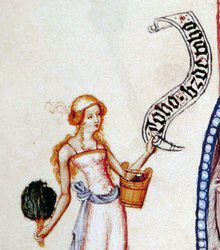
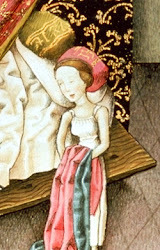
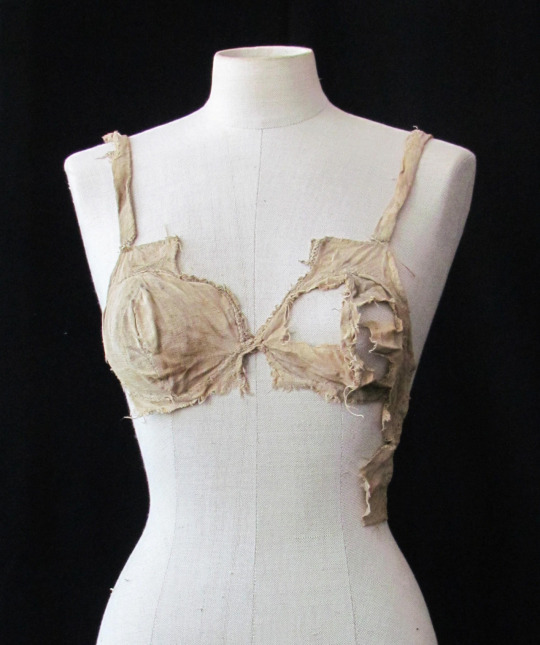
I sewed my own recreation of it (with some alterations because I made it for my everyday use, not as a historical recreation) and did a post about my results, where I go deeper into the history of the garment too. I didn't construct it very well and I did an error in the design of the back, which cause the strain of the shoulder straps to focus too much on very specific spots in the back panel, which eventually made the fabric there break too many times. (There were some other smaller design flaws too, like the waistline is lower than my natural waist so it rose and wrinkled annoyingly.) I did use it daily (except when I washed it) for a fairly long time though and it was super comfortable and helped a lot with back pain (and shoulder pain caused by use of modern bras). I hate that I've had to go back to modern bras because I haven't had the time to remake it yet. (I'll probably make a follow up post once I get around to it, where I go through the issues of the first version and how I addressed them in the next attempt.) Well fitted and shaped bodice which is then laced does surprisingly much even without any additional reinforcements.
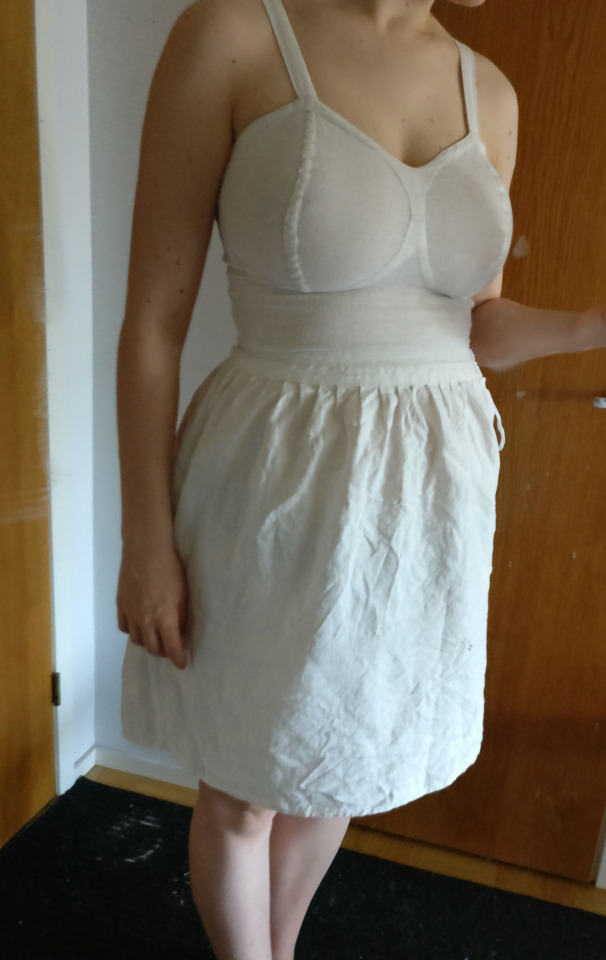

I haven't made a Medieval kirtle (though I will some day), but it was the more widely used Medieval supporting garment, which eventually replaced Bathhouse dress in the area where that was used. Kirtle is worn over a shift, but it broadly works similarly. Kirtles could be front, side or back laced depending on the time period and how the Kirtle was constructed. Multiple layers of kirtles could be used and looser overgarments (like houppelande) were often used on top of it. Kirtle was used by everyone, including men, but for those who didn't need bust support, it's purpose was mainly to create the fashionable silhouette. Here's three depictions of kirtles from 15th century. First unlaced, but has lacing on the front, second close up of the side lacing and third shows nicely how both front and side/backlacing shaped the bust.
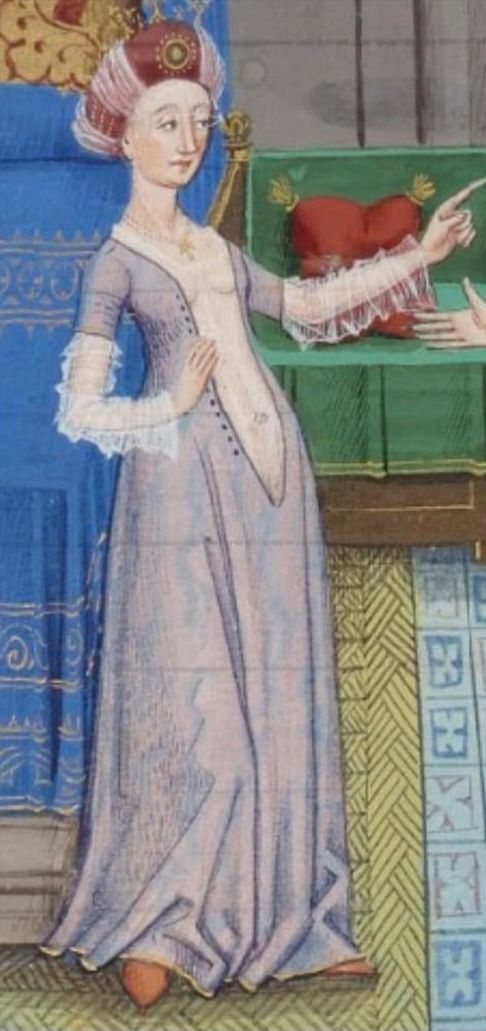
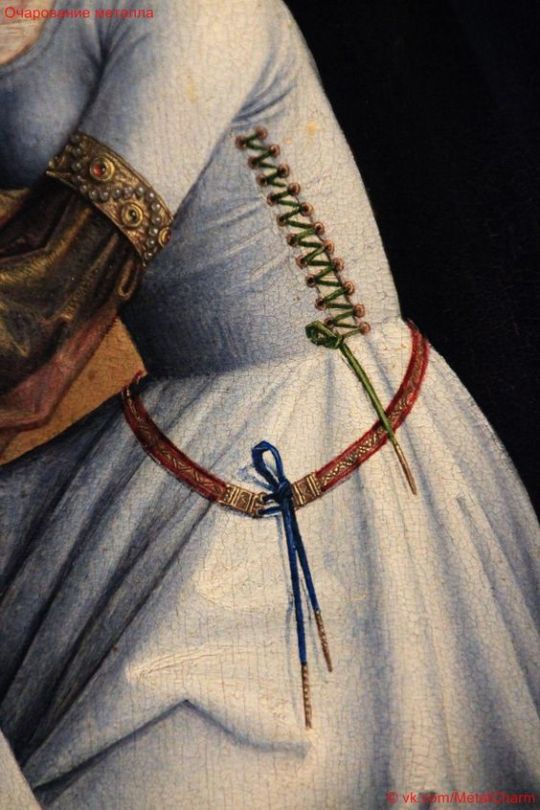
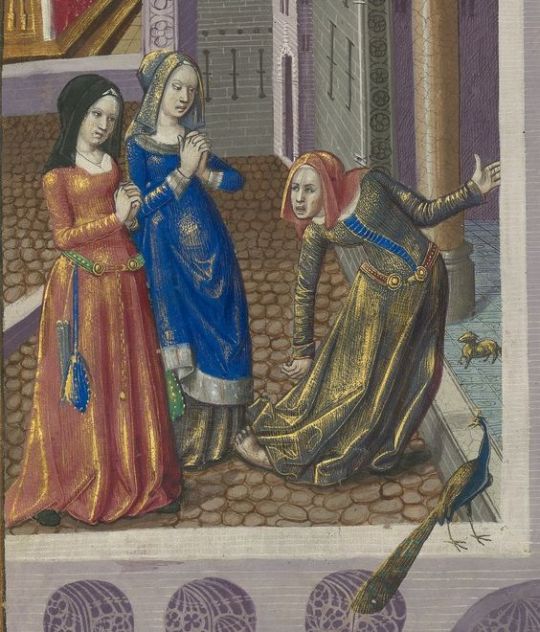
Morgan Donner is a costumer, who focuses a lot on Medieval costuming and has a big bust, so while I haven't personally tested the supportiveness of kirtle, she certainly has. The kirtle bodice part needs to be patterned to accommodate the breasts by giving it round shapes and the kirtle needs to be a little too small so there's room to lace it to fit well. Lining also helps to reinforce the fabric and make it more firm and supportive. Here's Morgan's pattern from the tutorial in her website and how the kirtle eventually fits for her. (Also look at the handsome boy in his handsome matching outfit.)
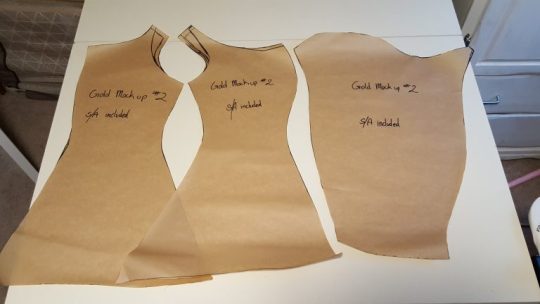
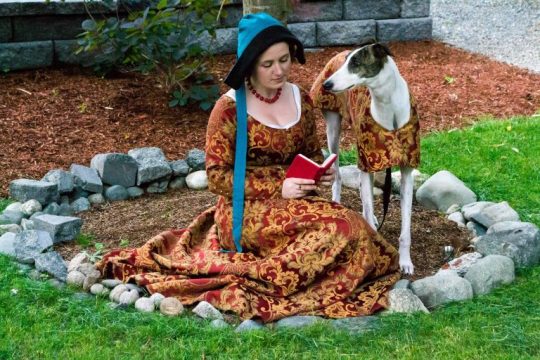
She also has a video relating to the same kirtle project, where she explains her method to pattern a kirtle specifically so it's supportive for big bust.
In 16th century more stiffness was added to kirtles, first with very stiff lining and then with boning, but that doesn't necessarily add to the bust support, rather it just allows the kirtle to shape the bust and the body in general more and better support a heavy skirt. Firm fabric secured snugly with lacing is already very good at distributing the weight of the boobs to the whole torso.
In conclusion, at least since 14th century people with our body type were not doomed to eternal back pain and even before that some ways to help with it were probably used.
#historical fashion#fashion history#dress history#history#historical costuming#historical sewing#sewing#crafts#costuming#fashion#medieval fashion
264 notes
·
View notes
Text




Joan wears a lot of these flowy overgarments but I’m not sure if the one I have is too flowy. Any thoughts?
I made Joan a little consulting detective ID card lol, to make this outfit seem at least a little bit more like a cosplay and not just like. Clothes on my body.
11 notes
·
View notes